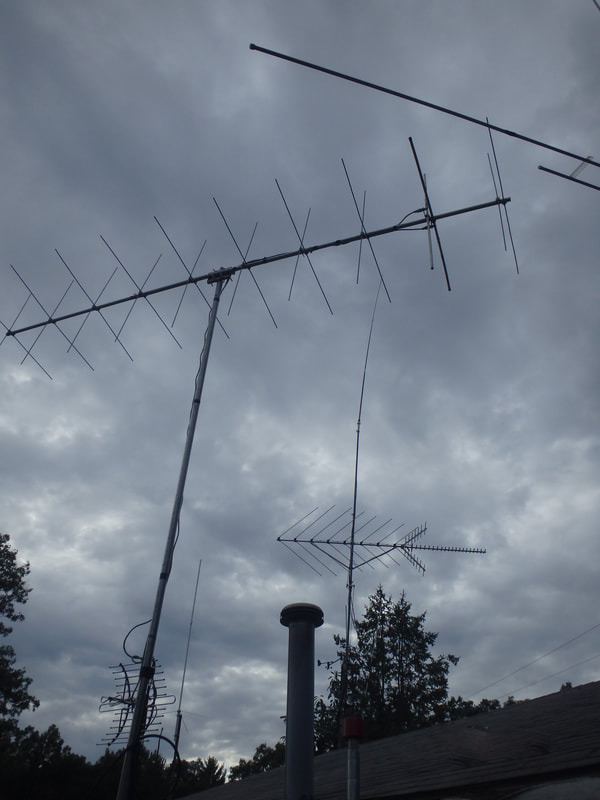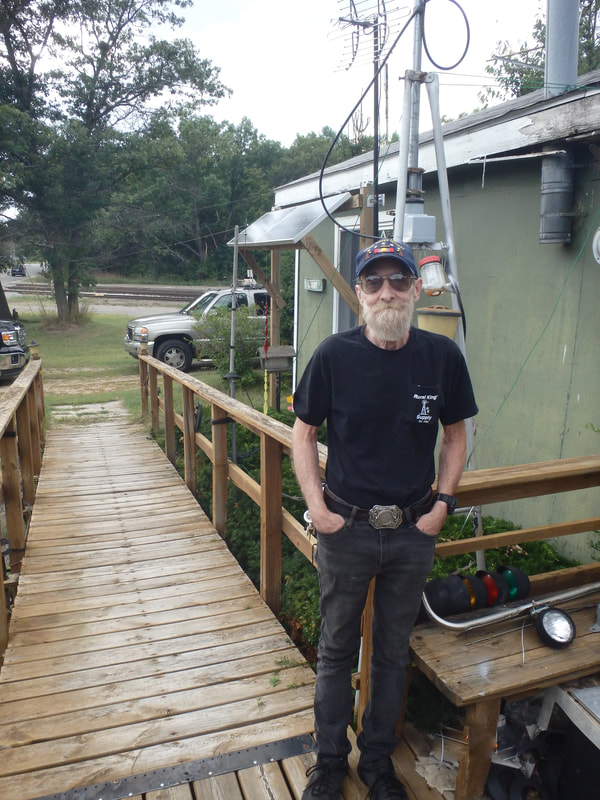|
A visit with Mr. Verne Williams White Cloud’s Amateur Radio Operator Extraordinaire. By Charles Chandler Mr. Verne Williams grew up near the Diamond Lake Tavern and has been a resident of White Cloud for a while. Of some local notoriety, he is the only baby ever born on the Hospital steps at Gerber Memorial Hospital. In White Cloud as you travel east on Pine Hill and immediately alongside the Pere Marquette railroad track you will notice Mr. Vern William’s home. A most interesting place and probably a perfect metaphor for Mr. Williams. It is small, compact and tastefully decorated with wind chimes, whirligigs, solar panels, U of M signs, bird feeders, and bits and pieces of electronic hardware. If you are not sure what is going on at this location just glance upward and count the antennas. There are about 23 and most were designed and built by Mr. Williams from repurposed and salvaged materials. This structure is Mr. William’s home and his Amateur Radio Station. Mr. Williams or KC8FUV is the well-known “go-to technical guy in the Amateur (Ham) radio world.” Amateur or Ham is a term that is used to differentiate Amateur radio or not for profit radio from commercial or for-profit radio. This front porch interview is about Verne and his views on the value of radio. For the technical folks, this is not going to be a TED talk. You can contact Verne and he will be happy to answer your technical questions about the science of Amateur Radio. I have had applied physics and understand radio at an academic level and spent some time in aircraft radio racks. However, I think that the phenomenon of speaking into a microphone and attaching that human voice to an energy wave and it is received and understood in Ludington, or London England by another Ham operator is pure and simple magic. Verne “has always enjoyed communication and started his career and hobby at about eight years old with a tin can and a string set up. His parents soon bought him a walkie talkie set and “I was hooked on radio communication for probably the next 60 years.” He has worked in “public and business band communication servicing and installing communication systems. He did a tour in the Army as a Communication Specialist and then began service and repair work for the likes of the Muskegon County Fire Departments. “I have been the Emergency Services Coordinator for Amateur Radio for Newaygo. Head training coordinator for Emergency Service Amateur Radio Training for Newaygo, Muskegon, Osceola, Lake, and Mecosta counties.” He has also been a member of the US Army MARS Program. It is the “Military Auxiliary Radio System (MARS) a United States Department of Defense-sponsored program, established as a separately managed and operated program by the United States Army, and the United States Air Force. The program is a civilian auxiliary consisting primarily of licensed amateur radio operators who are interested in assisting the military with communications on a local, national, and international basis as an adjunct to normal communications. MARS has a long history of providing worldwide auxiliary emergency communications during times of need. “The range of Ham radio transmission is not known and no one knows how far these transmissions can travel. Some operators with the right kind of antenna systems can do a moon bounce. We can aim the antenna on a particular angel at the moon and then bounce a signal to a different place around the earth. It is like shining a flashlight at an angle on a mirror. The light will then reflect off at an angle to another spot in the room.” Exposing the depth of my deficiency on the subject I asked Verne who and where was his audience? “See those radios antennas on my vehicles and the house here? My audience is other Amateur radio operators wherever they may be and we discuss a variety of topics. Technical topics, hunting, autos, really most any appropriate topic. My favorite quote is from Walter Cronkite. He was a Ham operator and said ‘Amateur Radio Operators are all but Amateurs’. Radio is not only our hobby but becomes a big part of our lives. We do things to serve the public.” According to Verne, the 9/11 disaster and other major disasters are the times with they provide assistance. During those tragic events, most communication links fail. They become overwhelmed, the 911 systems and most phone systems become overloaded and fail,. At this time those Armature Radio operators that have backup power, step up and provide limited communication services where other communication systems are failing.
This correspondent has experienced these failures on three different occasions. The first was during the Terrorist Attacks on the New York Trade Towers. I had been with friends on a mountaineering outing on Mt Saint Helens the day before the event. On September the 11th I was on an early morning American Airlines flight from Portland down to Dallas. After about 30 minutes we were diverted back to Portland. After we landed everything went quiet and I spent the next 5 days making my way back to Dallas. The other two times were during the Houston hurricanes. I tried for a couple of days to contact my kids to see if they had evacuated or were now on their rooftops. Very troubling times. “We always welcome new people that want to get started in Ham radio. I am happy to answer questions about and mentor anyone wanting to get involved in Ham Radio. For who we are, “in the beginning, Ham radio operator were mostly men, not necessarily by design but by interest, I guess. But slowly and surely more and more women became HAM operators. Now we have a great number of women who are Ham Radio operators. Ham Radio is very democratic and is open to anybody that takes the time to study, pass the exam and get a license to go on the air. There are no color barriers. no gender barriers, no race barriers, no ethnicity barriers, no religious or even age barriers to becoming a Ham radio operator. There is family over in Howard City and the mother, father, and eight-year daughter are all Ham operators. Verne mentioned that now you don’t need to know Morse Code to pass the exam. “The United States Federal Communications Commission phased out this requirement for all license classes on 23 February 2007.” It appears that you can get an entry-level Ham radio set for around $300.00. Verne suggested that you should build your antenna. He pointed to several rooftop examples that he had constructed from found items and old TV antennas. Verne said that he had been diagnosed with terminal cancer. He has soldiered through two rounds of treatment for esophagus, stomach and brain cancer. “Normally people with my type of cancer live three to seven months after treatment. I have stayed very upbeat about my situation and have not thrown in the towel and am still here. Each day I get up and try to find some way to contribute to Ham Radio. I build antennas, service radios, and microphones, design and build radio parts that you can’t get elsewhere. I have done this my whole life and will continue as long as I can.” “Lately, I have been dedicating a lot of time writing a book to leave behind to the Ham radio community. My purpose is to compile and document my years of experience, and knowledge in hopes that is can be used by other Ham operators. Creating this book that will help dispel some myths about Ham Radio and give a lot of information that other beginners or operators can have for free. I don’t want to Copywrite the book because it is not about making money. My only request is that if someone gets a copy, they make another copy and then pass that one on to someone else. I just want to be a productive member of society.” Well just shut the door. He didn’t state it specifically but it was obvious that Verne valued Amateur radio and felt strongly enough about its value that he is spending his precious time passing his technical and tribal knowledge along to other operators. Sitting on Verne’s front porch listening to his smooth radio voice and the occasional passing car bump over the railroad crossing was one of those rare moments that makes you pause and say thanks for the gift. SideBar: “For additional information about becoming an Amateur Radio Operator click on this link https://www.fcc.gov/wireless/bureau-divisions/mobility-division/amateur-radio-service. Many people start their involvement in amateur radio by finding a local club. Clubs often provide information about licensing, local operating practices, and technical advice. Newcomers also often study independently by purchasing books or other materials, sometimes with the help of a mentor, teacher, or friend. Amateur radio enthusiasts have significantly contributed to science, engineering, industry, and social services. Research by amateur operators has founded new industries, built economies, empowered nations, and saved lives in times of emergency. Ham radio can also be used in the classroom to teach English, map skills, geography, math, science, and computer skills.”
1 Comment
Update on the artical "Whatever Happened to Radio Part II: Getting The Skinny on Ham"dated !0/9/2019. Verne Williams
11/22/2019 11:11:13 am
Verne Williams has recently completed writing his book titled Communications Notes & Plans by Verne A. Williams. " I have furnished a printed copy and a digital copy to the White Cloud library" said Verne. Verne Wrote this book while enduring pain caused by his two battles with cancer. He does not sell the book to anyone and wrote the book to be read totally free by anyone wishing to read its wealth of information. The only cost you would incur is if you wanted a printed copy for yourself. That cost would be just what the library usually charges per page for photo copies. You can read a printed copy for free at the White Cloud library or if you bring your own USB flash drive the library will be happy to download a copy for you free of charge. The White Cloud library had agreed to furnish a digital copy to any other library who requests a digital copy from the White Cloud Library. If White Cloud is outside your normal travel area, Verne said "just have your local library contact the White Cloud library and request a digital copy be sent to your library. Verne Has written this book to be free for anyone who wishes to learn more about the how's and why's of amateur (ham) radio. In his book he has also included several easy to build electronic projects you can build for use with communications equipment. On the open market this information could cost the reader a pile of money however, Verne has elected to provide it freely.
Reply
Your comment will be posted after it is approved.
Leave a Reply. |
Archives
April 2024
Categories |


 RSS Feed
RSS Feed